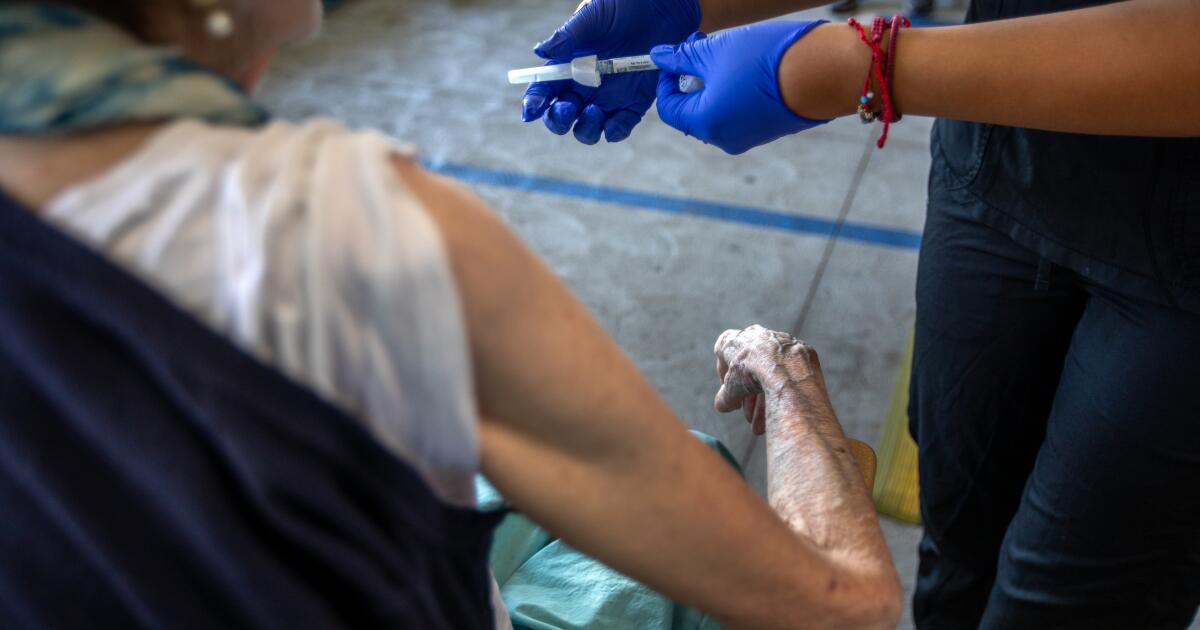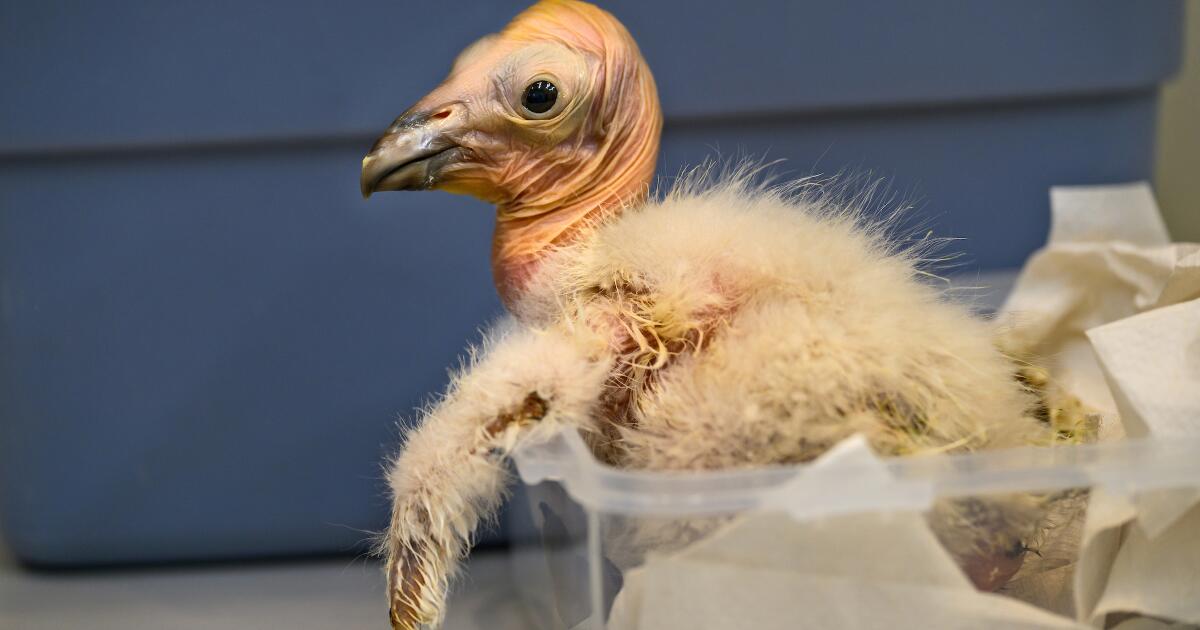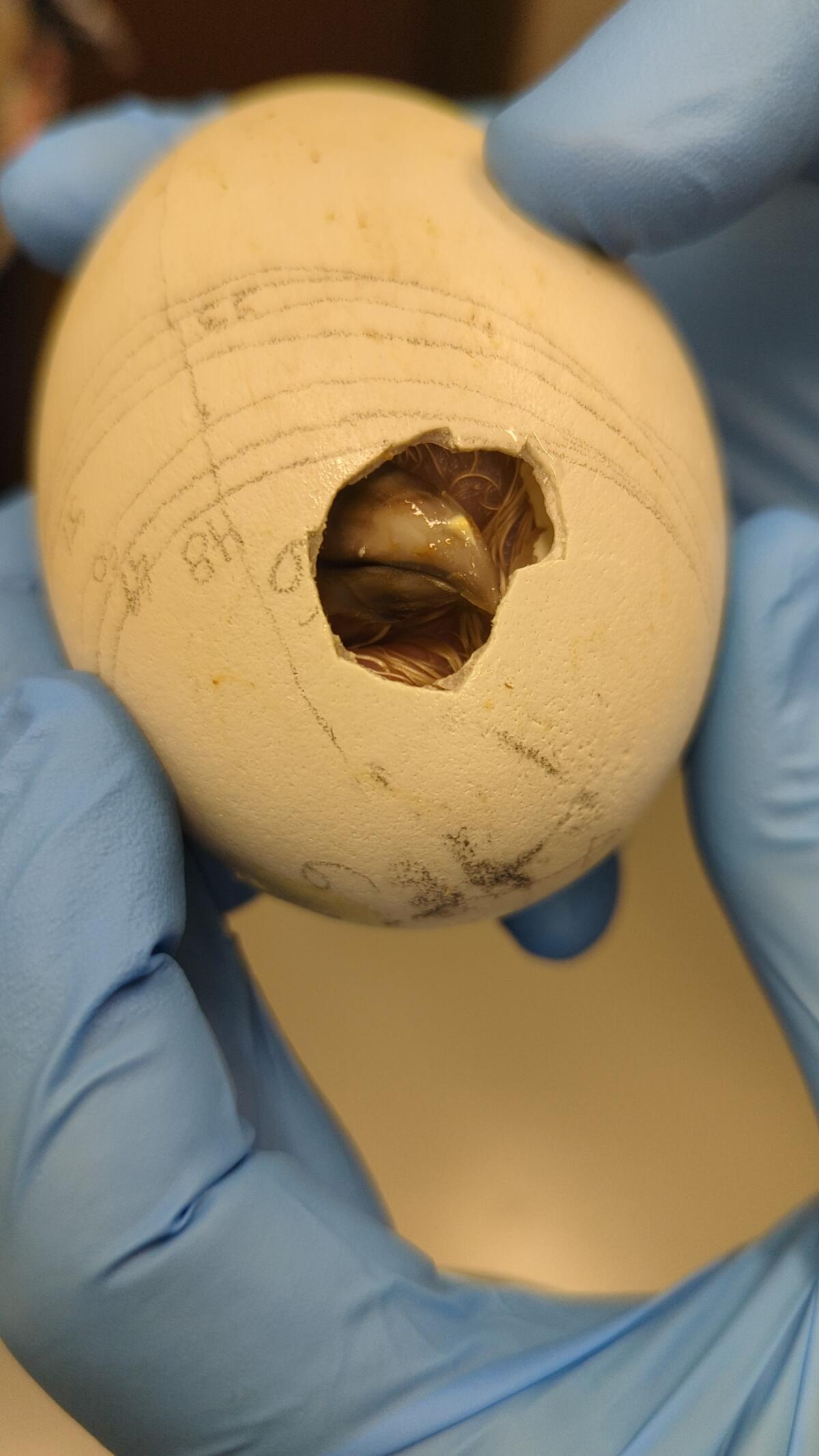Science
COVID, flu, RSV on the rise in California. Is another ‘tripledemic’ coming?

Respiratory virus season is ramping up in California, prompting health officials to renew their calls for residents to get vaccinated in hopes of reducing potential pressure on health systems across the state.
While conditions so far are nowhere near as daunting as last autumn — when hospitals labored under the strain of a “tripledemic” spawned by wide simultaneous circulation of COVID-19, flu and respiratory syncytial virus — the transmittable trio is on the rise.
Data show new COVID and flu hospital admissions are increasing in California, and Fresno County was forced to take steps last month to stem a tide of patients arriving in its emergency rooms, instructing ambulances to not transport patients to hospitals if they are stable and not suffering from an emergency.
Nationally, “RSV season is in full swing. The flu season is just beginning across most of the country, though accelerating fast. And while we’re seeing relatively low levels of COVID, COVID is still the primary cause of new respiratory hospitalizations and deaths, with about 15,000 hospitalizations and about 1,000 deaths every single week,” Dr. Mandy Cohen, director of the U.S. Centers for Disease Control and Prevention, told a House of Representatives subcommittee last week.
Of the three viruses, RSV is the most concerning in California in terms of community transmission, said Dr. Peter Chin-Hong, an infectious diseases expert at UC San Francisco. In Los Angeles County, for data released on Thursday, 13% of specimens tested for RSV came back positive, up from 9% two weeks prior.
“It is pretty high [and] hasn’t started to go down yet,” Chin-Hong said.
But despite recent increases, health officials say they have yet to see the sort of widespread issues that made the previous respiratory virus season so challenging. Last year at this time, children’s hospitals across California were under stress, with exceptionally high hospitalization rates related to RSV — including in Orange County, which declared a health emergency related to the virus.
“The interesting thing with RSV is that the levels of hospitalization isn’t the same crisis levels in pediatric hospitals as one year ago, when it peaked in November,” Chin-Hong said.
One possible reason is that since RSV was pretty severe last autumn, there might be some carryover immunity. Chin-Hong said that UC San Francisco’s pediatric hospitals are now about 90% full — “average for this time of year” — as opposed to being beyond capacity last year.
The availability of RSV vaccines for babies and young children, the elderly and those who are pregnant may also be helping, he added.
As of Nov. 18, coronavirus levels in L.A. County wastewater were at 24% of last winter’s peak, up from 13% the prior week.
That level, though still considered relatively low, is the highest seen since the end of September, when the county was recovering from a late summer COVID-19 uptick.
And for the week that ended Nov. 25, about 8% of specimens tested for flu at L.A. County labs were positive for the virus, up from about 7% the prior week.
“We believe flu season has begun,” the county Department of Public Health said in a statement to The Times. “Influenza is circulating in the community and on the rise.”
Doctors are also closely watching the latest upstart coronavirus subvariant — nicknamed “Pirola” but officially designated BA.2.86.
The CDC estimates that BA.2.86 constituted 8.8% of coronavirus cases over the two-week period that ended Nov. 25, up from 3% for the prior two-week period.
The CDC has been concerned that the strain’s unusually high number of mutations might empower it to more easily infect those who had previously caught the coronavirus or received an older vaccine formulation. However, emerging evidence indicates that the latest COVID-19 vaccine formula appears to provide strong protection against Pirola.
The rise of BA.2.86 should further encourage people, especially older individuals, to get the new vaccine this autumn, doctors say, as relying on old booster shots or natural immunity from a past infection may not be protective enough.
“If somebody’s at risk for getting seriously ill, particularly those who are older than 65, you can’t really rely on getting the old shot last year to really carry you through this winter,” Chin-Hong said. “You really need some replenishing of the antibodies, and that’s what the new vaccine will do.”
In L.A. County, just 21% of seniors have received the updated COVID-19 vaccination this autumn. Orange County reports that about 25% of its seniors have received the updated shot, as have 27% of seniors in San Diego and Ventura counties. In Riverside County, about 20% of seniors have received the latest shot, as have 17% of seniors in San Bernardino County.
Senior vaccination rates are much higher in the San Francisco Bay Area. Santa Clara County, the region’s most populous, has a senior vaccination rate of 36%; while San Francisco and Alameda County report a rate of 38%. Contra Costa and San Mateo counties report a rate of 40%, while Sonoma, Marin and Napa counties report even higher figures.
Statewide, 27% of California’s seniors have received the newest COVID-19 vaccination.
Meanwhile, global health officials are monitoring a significant rise in respiratory illness among children in northern China. Chin-Hong characterized the situation there as an “unprecedented number of kids and adolescents who are getting sick; a proportion of those are going to the hospital in very large numbers” — serious enough to prompt the World Health Organization to inquire what was going on.
Cohen, the CDC director, told House lawmakers last week that “we do not believe this is a new or novel pathogen,” but a combination of illnesses such as COVID-19, flu, RSV, as well as a bacterium called mycoplasma pneumoniae that can infect the respiratory system and trigger bronchitis or pneumonia.
“Chinese authorities advised that there has been no detection of any unusual or novel pathogens or unusual clinical presentations, including in Beijing and Liaoning, but only the aforementioned general increase in respiratory illnesses due to multiple known pathogens,” the WHO said in a statement last month. “They further stated that the rise in respiratory illness has not resulted in patient loads exceeding hospital capacities.”
Other areas of the world noting reports of mycoplasma or a rise in pneumonia affecting children include Denmark and the Netherlands, Chin-Hong said.
Stateside, Warren County, Ohio, has also reported what local officials called “an extremely high number of pediatric pneumonia cases being reported this fall season.” No deaths have been reported, however, and most of the ill children recover at home and have been given antibiotics.
“The increase in reported pneumonia cases is not suspected of being a new/novel respiratory virus but rather a large uptick in the number of typical pediatric pneumonia cases,” the Warren County Health District said in a statement. “There has been zero evidence of this outbreak being connected to other outbreaks, either statewide, nationally or internationally.”
Some health officials have taken notice of reports from China. A statement posted to a Taiwanese government website Sunday said that officials there have not seen “a rapid surge in respiratory infections similar to China,” but rather a drop in flu-like cases in recent weeks.
Taiwan’s premier, Chen Chien-jen, who is also an epidemiologist, was quoted in the government statement as saying the surge in respiratory illness in China is mostly related to flu, but also rhinoviruses — the most frequent cause of the common cold — mycoplasma pneumoniae, adenoviruses and coronaviruses. Still, “the government has increased surveillance measures for related infectious pathogens,” the statement said.
There are several possible, competing explanations as to why China is seeing such a rise in respiratory illness among children. One is that this is the first autumn-and-winter season after the end of COVID-era lockdowns there, and children are going to see a surge in illness after years of not being exposed to viruses, Chin-Hong said.
Mycoplasma is a possible culprit, as the bacterium surges every few years or so, but it can be treated with antibiotics.
The third explanation, Chin-Hong said, is there’s “something that we don’t know about yet that’s causing this illness. And I guess some of that rationale is that we’re also seeing ‘kid pneumonias’ in other parts of the world at the same time, [places that] reopened much earlier than China.”
One reassuring data point is there haven’t been reports of more kids dying from this wave of pediatric pneumonia, or overly taxing hospitals. “But again, it’s something to watch as the season progresses,” Chin-Hong said.
For children who do get a respiratory illness, a warning sign to take them to the hospital is if they are struggling to breathe, Chin-Hong said. A warning sign for young children is if they have difficulty feeding or become lethargic.

Science
Q&A: Learn how Olympians keep their cool from Team USA's chief sports psychologist

Your morning jog or weekly basketball game may not take place on an Olympic stage, but you can use Team USA’s techniques to get the most out of your exercise routine.
It’s not all about strength and speed. Mental fitness can be just as important as physical fitness.
That’s why the U.S. Olympic & Paralympic Committee created a psychological services squad to support the mental health and mental performance of athletes representing the Stars and Stripes.
“I think happy, healthy athletes are going to perform at their best, so that’s what we’re striving for,” said Jessica Bartley, senior director of the 15-member unit.
Bartley studied sports psychology and mental health after an injury ended her soccer career. She joined the USOPC in 2020 and is now in Paris with Team USA’s 592 competitors, who range in age from 16 to 59.
Bartley spoke with The Times about how her crew keeps Olympic athletes in top psychological shape, and what the rest of us can learn from them. Her comments have been edited for length and clarity.
Why is exercise good for mental health?
It gets you moving. It gets the endorphins going. And there’s often a lot of social aspects that are really helpful.
There are a number of sports that stretch your brain in ways that can be really, really valuable. You’re thinking about hand-eye coordination, or you’re thinking about strategy. It can improve memory, concentration, even critical thinking.
What’s the best way to get in the zone when it’s time to compete?
When I work with athletes, I like to understand what their zone is. If a 0 or a 1 is you’re totally chilled out and a 10 is you’re jumping around, where do you need to be? What’s your number?
People will say, “I’m at a 10 and I need to be at an 8 or a 7.” So we’ll talk about ways of bringing it down, whether it’s taking a deep breath, listening to relaxing music, or talking to your coach. Or there’s times when people say they need to be more amped up. That’s when you see somebody hitting their chest, or jumping up and down.
If you make a mistake in the middle of a competition, how do you move on instead of dwelling on it?
I often teach athletes a reset routine. I played goalie, so I had a lot of time to think after getting scored on. I would undo my goalie gloves and put them back on, which to me was a reset. I would also wear an extra hairband on my wrist, and when I would snap it, that meant I needed to get out of my head.
It’s not just a physical reset — it helps with a mental reset. If you do the same thing every single time, it goes through the same neural pathway to where it’s going to reset the brain. That can be really impactful.
Do Olympic athletes have to deal with burnout?
Oh, yeah. Everybody has a day where they don’t want to do whatever it is. That’s when you have to ask, “What’s in my best interests? Do I need a recovery day, or do I really need to get in the pool, or get in the gym?”
Sometimes you really do need what we like to refer to as a mental health day.
How can you psych yourself up for a workout when you just aren’t feeling it?
It’s really helpful to think about why you’re doing this and why you’re pushing yourself. Do you have goals related to an activity or sport? Is there something tied to values around hard work or discipline, loyalty or dependability?
When you don’t want to get in the gym, when you don’t want to go for a run, think about something bigger. Tie it back to values.
Is sleep important for maintaining mental health?
Yes! We started doing mental health screens with athletes before the Tokyo Games. We asked about depression, anxiety, disordered eating and body image, drugs and alcohol, and sleep. Sleep was actually our No. 1 issue. It’s been a huge initiative for us.
How much sleep should we be getting?
It’s different for everyone, but generally we know seven to nine hours of sleep is good. Sometimes some of these athletes need 10 hours.
I highly recommend as much sleep as you need. If you didn’t get enough sleep, napping can be really valuable.
Is napping just for Olympic athletes or is it good for everybody?
Everybody! Naps are amazing.
What if there’s no time for a nap?
There are different ways of recharging. Naps could be one of them, but maybe you just need to get off your feet for 20 minutes. Maybe you need to do a meditation or mindfulness exercise and just close your eyes for five minutes.
How do you minimize the effects of jet lag?
We try to shift one hour per day. That’s the standard way of doing it. If you can, it’s super helpful. But it’s not always possible.
The thing we tell athletes is that our bodies are incredible, and you will even things out if you can get back on schedule. One or two nights of crummy sleep is not going to impact your overall performance.
What advice do you give athletes who have trouble falling asleep the night before a competition?
You don’t want to change much right before a competition, so I usually direct athletes to do what they would normally do.
Do you need to unwind by reading a book? Do you need to talk on the phone with somebody and get your mind off things? Can you put your mind in a really restful place and think about things that are really relaxing?
Are there any mindfulness or meditation exercises that you find helpful?
There are some athletes who benefit greatly from an hourlong meditation. I love something quick, something to reset my brain, maybe close my eyes for a minute.
If I’m feeling like I need to take a moment, I love mindful eating. You savor a bite and go, “Oh, my gosh, I have not been fully engaged with my senses today.” Or you could take a mindful walk and take in the sights, the smells, all of the things that are around you.
What do you eat when you need a quick nutrition boost?
Cashews. I tend to carry those with me. They’ve got enough energy to make sure I keep going, physically.
I’ve always got gummy bears on me too. There’s no nutritional value but they keep me going mentally. I’m a big proponent of both.
Is it OK to be superstitious in sports?
It depends how flexible you are. Maybe you put on your socks or shoes a certain way, or listen to certain music. Routines are really soothing. They set your brain up for success in a particular performance. It can be really, really helpful.
But I’ve also seen an athlete forget their lucky underwear or their lucky socks, and they’re all out of sorts. So your routine has to be flexible enough that you’re not going to completely fall apart if you don’t do it exactly.
Are Olympians made of stronger psychological stuff than the rest of us?
Not necessarily. There are some who don’t get feathers ruffled and have a high tolerance for the fanfare. There’s also a lot of regular human beings who just happen to be fantastic at a particular activity.
Science
‘Ready, Steady, Slow’: Championship Snail Racing at 0.006 M.P.H.

Earlier this month, the rural village of Congham, England, played host to a less likely group of athletes: dozens of garden snails. They had gathered to compete in the World Snail Racing Championships, where the world record time for completing the 13.5 inch course stands at 2 minutes flat. At that speed — roughly 0.006 miles per hour — it would take the snails more than six days to travel a mile.
Science
Caring for condor triplets! Record 17 chicks thrive at L.A. Zoo under surrogacy method

A new method of rearing California condors at the Los Angeles Zoo has resulted in a record-breaking 17 chicks hatched this year, the zoo announced Wednesday.
All of the newborn birds will eventually be considered for release into the wild under the U.S. Fish and Wildlife Service’s California Condor Recovery Program, a zoo spokesperson said.
“What we are seeing now are the benefits of new breeding and rearing techniques developed and implemented by our team,” zoo bird curator Rose Legato said in a statement. “The result is more condor chicks in the program and ultimately more condors in the wild.”
Breeding pairs of California condors live at the zoo in structures the staff “affectionately calls condor-miniums,” spokesperson Carl Myers said. When a female produces a fertilized egg, the egg is moved to an incubator. As its hatching approaches, the egg is placed with a surrogate parent capable of rearing the chick.
California condor eggs are cared for at L.A. Zoo. The animal is critically endangered.
(Jamie Pham / L.A. Zoo)
This bumper year of condor babies is the result of a modification to a rearing technique pioneered at the L.A. Zoo.
Previously, when the zoo found itself with more fertilized eggs than surrogate adults available, staff raised the young birds by hand. But condors raised by human caretakers have a lower chance of survival in the wild (hence the condor puppets that zookeepers used in the 1980s to prevent young birds from imprinting on human caregivers).
In 2017, the L.A. Zoo experimented with giving an adult bird named Anyapa two eggs instead of one. The gamble was a success. Both birds were successfully released into the wild.
Faced with a large number of eggs this year, “the keepers thought, ‘Let’s try three,’” Myers said. “And it worked.”
The zoo’s condor mentors this season ultimately were able to rear three single chicks, eight chicks in double broods and six chicks in triple broods. The previous record number of 15 chicks was set in 1997.
Condor experts applauded the new strategy.
“Condors are social animals and we are learning more every year about their social dynamics. So I’m not surprised that these chick-rearing techniques are paying off,” said Jonathan C. Hall, a wildlife ecologist at Eastern Michigan University. “I would expect chicks raised this way to do well in the wild.”
The largest land bird in North America with an impressive wingspan up to 9½ feet, the California condor could once be found across the continent. Its numbers began to decline in the 19th century as human settlers with modern weapons moved into the birds’ territory. The scavenger species was both hunted by humans and inadvertently poisoned by lead bullet fragments embedded in carcasses it ate. The federal government listed the birds as an endangered species in 1967.

A condor, one of a record-breaking 17 at the zoo, makes its way out of its shell.
(Jamie Pham / L.A. Zoo)
When the California Condor Recovery Program began four decades ago, there were only 22 California condors left on Earth. As of December, there were 561 living individuals, with 344 of those in the wild. Despite the program’s success in raising the population’s numbers, the species remains critically endangered.
In addition to the ongoing threat of lead poisoning, the large birds are also at risk from other toxins. One 2022 study found more than 40 DDT-related compounds in the blood of wild California condors — chemicals that had made their way from contaminated marine life to the top of the food chain.
“Despite our success in returning condors to the wild, free-flying condors continue to face many obstacles with lead poisoning being the No. 1 cause of mortality,” said Joanna Gilkeson, spokesperson for Fish and Wildlife’s Pacific Southwest Region. “Innovative strategies, like those the L.A. Zoo is implementing, help us to produce more healthy chicks and continue releasing condors into the wild.”
The chicks will remain in the zoo’s care for the next year and a half before they are evaluated for potential release to the wild. Thus far, the zoo has contributed 250 condor chicks to Fish and Wildlife’s program, some of which the agency has redeployed to other zoos as part of its conservation efforts.
In a paper published earlier this year, a team of researchers found that birds born in captivity have slightly lower survival rates for their first year or two but then have equally successful outcomes to wild-hatched birds.
“Because condors reproduce slowly, releases of captive-bred birds are essential to the recovery of the species, especially in light of ongoing losses due to lead-related mortality,” said Victoria Bakker, a quantitative ecologist at Montana State University and lead author of the paper. “The team at the L.A. Zoo should be recognized for their innovative and important contributions to condor recovery.”
-

 World1 week ago
World1 week agoOne dead after car crashes into restaurant in Paris
-

 Midwest1 week ago
Midwest1 week agoMichigan rep posts video response to Stephen Colbert's joke about his RNC speech: 'Touché'
-

 News1 week ago
News1 week agoVideo: Young Republicans on Why Their Party Isn’t Reaching Gen Z (And What They Can Do About It)
-

 News1 week ago
News1 week agoIn Milwaukee, Black Voters Struggle to Find a Home With Either Party
-

 Politics1 week ago
Politics1 week agoFox News Politics: The Call is Coming from Inside the House
-

 Movie Reviews1 week ago
Movie Reviews1 week agoMovie Review: A new generation drives into the storm in rousing ‘Twisters’
-

 News1 week ago
News1 week agoVideo: J.D. Vance Accepts Vice-Presidential Nomination
-

 World1 week ago
World1 week agoTrump to take RNC stage for first speech since assassination attempt















